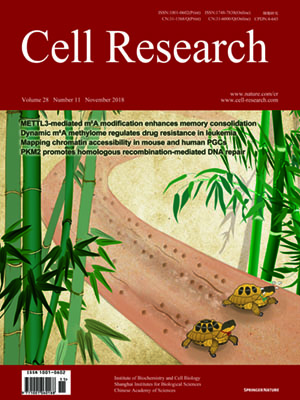
Volume 28, No 11, Nov 2018
ISSN: 1001-0602
EISSN: 1748-7838 2018
impact factor 17.848*
(Clarivate Analytics, 2019)
Volume 28 Issue 11, November 2018: 1090-1102 | Open Access
ORIGINAL ARTICLES
Pyruvate kinase M2 regulates homologous recombination-mediated DNA double-strand break repair
Steven T. Sizemore 1, Manchao Zhang 2, Ju Hwan Cho 1, Gina M. Sizemore 3, Brian Hurwitz 4, Balveen Kaur 1,4, Norman L. Lehman 5,Michael C. Ostrowski 3, Pierre A. Robe 6,7, Weili Miao 8, Yinsheng Wang8, Arnab Chakravarti1 and Fen Xia2
1Department of Radiation Oncology, Arthur G James Comprehensive Cancer Center and Richard L. Solove Research Institute, The Ohio State University Medical Center, Columbus,
OH 43210, USA; 2Department of Radiation Oncology, University of Arkansas for Medical Sciences, Little Rock, AR 72205, USA; 3Department of Cancer Biology & Genetics, Arthur G
James Comprehensive Cancer Center and Richard L. Solove Research Institute, The Ohio State University Medical Center, Columbus, OH 43210, USA; 4Department of Neurological Surgery, Arthur G James Comprehensive Cancer Center and Richard L. Solove Research Institute, The Ohio State University Medical Center, Columbus, OH 43210, USA; 5Department of Pathology, Arthur G James Comprehensive Cancer Center and Richard L. Solove Research Institute, The Ohio State University Medical Center, Columbus, OH
43210, USA; 6Department of Neurology and Neurosurgery, Rudolf Magnus Brain Institute, University Medical Center of Utrecht, Utrecht, The Netherlands; 7Departments of Neurosurgery and Human Genetics, University of Liege, Liege, Belgium and 8Department of Chemistry, University of California, Riverside, CA 92521, USA
Correspondence: Correspondence: Fen Xia (FXia@uams.edu)These authors contributed equally: Steven T. Sizemore, Manchao Zhang, Ju Hwan Cho.
Resistance to genotoxic therapies is a primary cause of treatment failure and tumor recurrence. The underlying mechanisms that activate the DNA damage response (DDR) and allow cancer cells to escape the lethal effects of genotoxic therapies remain unclear. Here, we uncover an unexpected mechanism through which pyruvate kinase M2 (PKM2), the highly expressed PK isoform in cancer cells and a master regulator of cancer metabolic reprogramming, integrates with the DDR to directly promote DNA double-strand break (DSB) repair. In response to ionizing radiation and oxidative stress, ATM phosphorylates PKM2 at T328 resulting in its nuclear accumulation. pT328-PKM2 is required and sufficient to promote homologous recombination (HR)-mediated DNA DSB repair through phosphorylation of CtBP-interacting protein (CtIP) on T126 to increase CtIP’s recruitment at DSBs and resection of DNA ends. Disruption of the ATM-PKM2-CtIP axis sensitizes cancer cells to a variety of DNA-damaging agents and PARP1 inhibition. Furthermore, increased nuclear pT328-PKM2 level is associated with significantly worse survival in glioblastoma patients. Combined, these data advocate the use of PKM2-targeting strategies as a means to not only disrupt cancer metabolism but also inhibit an important mechanism of resistance to genotoxic therapies.
https://doi.org/10.1038/s41422-018-0086-7
FULL TEXT | PDF
Browse 1095


